|
by Mario Cecarini
ASTROPHYTUM Lemaire 1839
Historical notes
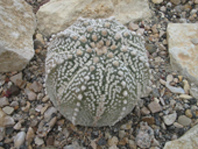 Astrophytums, whose name is derived from Greek ‘aster’ (star) and ‘phyton’ (plant), have always exercised their particular charm on cactus lovers, a charm that has been growing since numerous, stunning hybrids became commercially available. Astrophytums, whose name is derived from Greek ‘aster’ (star) and ‘phyton’ (plant), have always exercised their particular charm on cactus lovers, a charm that has been growing since numerous, stunning hybrids became commercially available.
In 1827, Thomas Coulter found an unknown specimen in the Mexican state of Hidalgo, a plant known today as A. ornatum but then described by De Condolle in 1828 with the name of Echinocactus ornatus. In 1839, Charles Lemaire gave the name of A. myriostigma to a plant that had been found in Norther Mexico. During the same year, H.G. Galeotti named a plant found in San Luis Potosí Cereus callicoche, which would later become A. myriostigma. In 1845, also J. G. Zuccarini described a specimen found two years before by Karwinsky as Echinocactus asterias.
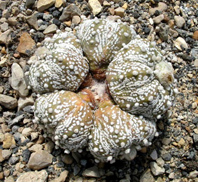 In 1851, Poselger found a new species in Coahuila. This species was described by Dietrich as Echinocactus capricornis, which would later be named A. capricorne. Moeller, in 1927, gave the name of Echinocactus myriostigma ssp. coahuilense to a plant that in 1932 would be renamed A. coahuilense by Kayser. In 1851, Poselger found a new species in Coahuila. This species was described by Dietrich as Echinocactus capricornis, which would later be named A. capricorne. Moeller, in 1927, gave the name of Echinocactus myriostigma ssp. coahuilense to a plant that in 1932 would be renamed A. coahuilense by Kayser.
After various events, Astrophytums have been associated with the subgenus of Echinocactus (Schumann), therefore as tribe of Echinocactaneae (Britton & Rose), to be later classified as part of the 6th tribe of Notocacteae (Buxbaum). Only in 1922 were Astrophytums elevated to the rank of genus by Britton & Rose in their fundamental work “The Cactaceae”.
Further and more in-depth studies, carried out with the help of the scanning electron microscope on seeds, along with analyses on DNA have challenged Buxbaum's thesis but have not yet provided a definitive systematic collocation for Astrophytums, which now belong to the subfamily of Cactoideae, tribe of Cacteae.
Morphology
It is a solitary plant, either globular or columnar in shape, with no shoots and few more or less prominent ribs. The stem colour can vary from green to glaucous and typical white tufts are borne along the ribs (trichomes). The stem turns a deep brown with age, from the base upwards. Tubercles are absent, while spines, whether stiff or flexible, straight or curved and twisted, can be observed only in A. capricorne and A. ornatum. Roots are fibrous, shallow and widespread; Only A. asterias and A. caput-medusae have a tap root system. Flowers are funnel-shaped, diurnal, yellow-coloured with throat that may be red and are borne at the plant apex. The anthesis lasts for two up to three days. Fruits are mostly dry, dehiscent (they naturally split open when mature), round-shaped with hairs on the skin and ripe quickly. The brown seeds are shiny and smooth, 2 to 4 mm in diameter, germinate readily and are generally dispersed by ants. Astrophytums are found in the southern part of Texas as well as in northern and central Mexico in either mountainous or hilly regions on calcareous soil.
Acknowledged species
Astrophytum asterias (Zuccarini), Lemaire 1868
Astrophytum capricorne (A. Dietrich), Britton & Rose 1922
Astrophytum myriostigma, Lemaire 1839
Astrophytum ornatum (A.P. De Condolse), Britton & Rose 1922
A. ASTERIAS (Zuccarini) Lemaire, 1868.
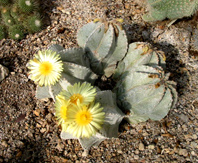 The species occurs in Texas (US) and in the Mexican States of Tamaulipas and Nuevo León, on flat, clayey lands. It is a globular, solitary plant, 6 to 10 cm in diameter, 4 to 8 cm tall, with grey to green stem covered with many trichomes. The tap root is fleshy and has numerous thin hairs. Plants usually have eight ribs with shallow furrows in between, prominent areoles and no spines. Flowers appear when the stem diameter reaches 3 centimetres; they are yellow with red or orange throat, 4-5 cm in diameter and are borne at the areoles near the top. Fruits are round-shaped berries which, once ripe, spontaneously fall from the plant. It is a showy and choice species and is included in CITES Appendix I. The species occurs in Texas (US) and in the Mexican States of Tamaulipas and Nuevo León, on flat, clayey lands. It is a globular, solitary plant, 6 to 10 cm in diameter, 4 to 8 cm tall, with grey to green stem covered with many trichomes. The tap root is fleshy and has numerous thin hairs. Plants usually have eight ribs with shallow furrows in between, prominent areoles and no spines. Flowers appear when the stem diameter reaches 3 centimetres; they are yellow with red or orange throat, 4-5 cm in diameter and are borne at the areoles near the top. Fruits are round-shaped berries which, once ripe, spontaneously fall from the plant. It is a showy and choice species and is included in CITES Appendix I.
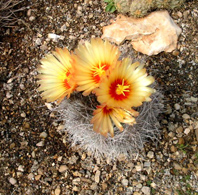 A. CAPRICORNE (A. Dietrich) Britton & Rose, 1922. A. CAPRICORNE (A. Dietrich) Britton & Rose, 1922.
Globular, solitary plant with brilliant green, slightly columnar stem when mature with oval areoles; it is found in the Chihuahuan desert in Coahuila State. It can grow 10 to 20 centimetres tall and usually has 8 ribs (sometimes more) which may be somewhat spiralled, trichomes and 15 to 20 brownish twisted spines up to 10 cm long. Flowers are yellow with orange throat, 5-6 cm large; the red fruits are dehiscent and ripe quickly.
A few varieties are worth a mention:aurum, crassispinum, minus, niveum, senile.
A. MYRIOSTIGMA Lemaire, 1839.
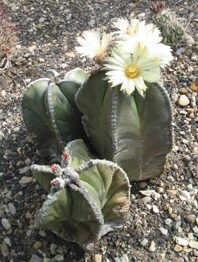 Plants have a globular form and can reach 18 centimetres in diameter and adult specimens can attain up to 25 centimetres in height; ribs are usually five (rarely six) and triangular, areoles are circular and spines are absent. The yellow flowers are 5-7 cm large and fruits are green and dehiscent. Their natural habitat lies between 1000 and 1200 metres of altitude in Central Mexico, namely the States of San Luis Potosí and Tamaulipas, particularly in the Chihuahuan desert. Plants have a globular form and can reach 18 centimetres in diameter and adult specimens can attain up to 25 centimetres in height; ribs are usually five (rarely six) and triangular, areoles are circular and spines are absent. The yellow flowers are 5-7 cm large and fruits are green and dehiscent. Their natural habitat lies between 1000 and 1200 metres of altitude in Central Mexico, namely the States of San Luis Potosí and Tamaulipas, particularly in the Chihuahuan desert.
This cactus is extremely variable when it comes to habit, number of ribs and dots, so much that it has been possible to raise many different varieties, forms and cultivars which have generated some confusion. Here are the taxa that at this moment are not accepted: A. coahuilense, A. columnaris, A. potosinum, A. tulense, A. tamaulipense, all grouped within A. myriostigma. However, we must notice that A. coahuilense is more akin to A. capricorne v. senile than it is to A. myriostigma.
The variety nudum is characterized by a brilliant green stem, 5 rounded ribs with no trichomes and its natural habitat is located at high elevations.
A. ORNATUM (A.P. De Condolle) Britton & Rose, 1922.
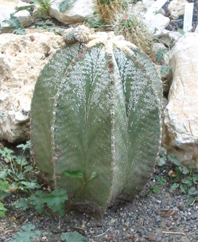 This globular, solitary plant, becoming columnar with age, can grow 1 metre tall or more. The dark green stem turns corky as plant ages; areoles have a yellowish fluff. Ribs, sometimes spiralled, are usually 8 with sharp edges. Spination is robust and consists of 5 to 10 spines arranged radially around a central one; they are yellow-coloured but may turn grey or brown with age. Flowers have a diameter of 6 to 8 centimetres, are yellow with a pistil of the same colour; fruits are dehiscent. Their habitat is located in Central Mexico, namely the States of Queretaro, Hidalgo, Guanajuato, San Luis Potosí, on the steep sunny scarps of river valleys. This globular, solitary plant, becoming columnar with age, can grow 1 metre tall or more. The dark green stem turns corky as plant ages; areoles have a yellowish fluff. Ribs, sometimes spiralled, are usually 8 with sharp edges. Spination is robust and consists of 5 to 10 spines arranged radially around a central one; they are yellow-coloured but may turn grey or brown with age. Flowers have a diameter of 6 to 8 centimetres, are yellow with a pistil of the same colour; fruits are dehiscent. Their habitat is located in Central Mexico, namely the States of Queretaro, Hidalgo, Guanajuato, San Luis Potosí, on the steep sunny scarps of river valleys.
Many botanists believe that A. ornatum v. mirbelii should not be considered a variety of its own, given the minimal genetic differences with the species, despite geographic isolation of the gene pools.
A. CAPUT-MEDUSAE (Velazco & Nevárez) D. Hunt, 2002.
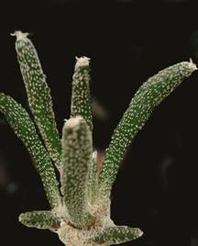 It's a new solitary species, rarely forming clumps that can grow 20 cm tall with napiform (turnip-shaped), fleshy root and ribless, hairy stem bearing cylindrical or triangular tubercles. The epidermis shows glaucous green vescicles, flowers are 5 cm large and fruits are egg-shaped and dehiscent. It was first observed on a plateau at around 200 metres of altitude in the State of Nuevo León. It's a new solitary species, rarely forming clumps that can grow 20 cm tall with napiform (turnip-shaped), fleshy root and ribless, hairy stem bearing cylindrical or triangular tubercles. The epidermis shows glaucous green vescicles, flowers are 5 cm large and fruits are egg-shaped and dehiscent. It was first observed on a plateau at around 200 metres of altitude in the State of Nuevo León.
It is still unclear whether Hunt's nomenclature stands on firmer ground than the original species name of Digistigma caput-medusae.
HYBRIDS
The first breeder that we know of is the French abbot Béguin who, in the late 1800s, crossbred A. Myriostigma with Echinocactus ornatus obtaining vigorous offsprings. During the 1900s many botanists dedicated themselves to breeding. In 1925, O. Sadovsky carried out many experiments crossbreeding different species and, in 1927, H. Möller found out that interbreeding does not occur between species with red-throated flowers and those with yellow-throated flowers, since they evolved along different genetic lines. From 1927 to 1971, R. Gräser obtained specimens of A. myriostigma with three ribs, capable of generating offsprings via sexual reproduction. In 1944, M. Megata conducted numerous studies following scientific criteria.
Astrophytums can be crossbred quite easily and anyone can do it; however there is no record of hybridisation in the wild, maybe because of the harsh conditions in which these plants live.
Japanese amateurs have successfully devoted themselves to the creation of hybrids and, with time and dedication, they have been able to obtain some remarkable varieties. Among these is the famous Super kabuto, named by Tony Sato, obtained from A. asterias. Sowing Super kabuto seeds we can expect seedlings to come true in a percentage between 25% and 30%. Another well-known and sought-after cultivar is Onzuka, obtained from A. myriostigma.
As regards nomenclature, first we specify the name of the specimen receiving pollen (mother plant). If we deposit pollen from myriostigma onto the stigma of ornatum, we will obtain plants with five ribs; the opposite process produces plants with more ribs. A. asterias may be crossbred with capricorne and coahuilense and vice versa, often obtaining very nice specimens, especially with second and third generations.
Cultivation
The mix for A. ornatum and myriostigma can be obtained combining 50% of volcanic lapillus (2-4 mm.), 20% of standard potting mix, 30% of pozzolan; all the other species prefer an even more mineral soil. You should never re-use old soil. Because of their taproots you need deep containers for A. asterias and A. caput-medusae; the opposite is true for the rest of the species. Since they thrive in alkaline soil (pH 8.5), you may water them with hard tap water or, if your water is soft, add some marble dust or crushed oyster shells to the mix. During the cold months, Astrophytums need to be kept strictly dry at a temperature of about 6°C.
Watch out for root mealy bugs, but most of all for fungal diseases, fostered by excess humidity and dripping of condensed water which may occur inside a greenhouse. A good measure to prevent this kind of diseases is using a fungicide, such as benomyl or a similar one, at the beginning and at the end of the growing season. Apply a low-nitrogen fertilizer two to three times a year, when plants are growing. They enjoy full sun and thorough but not too frequent waterings. The most delicate species is asterias.
Astrophytum seeds mature rapidly and germination at 25°C is also quick. Flowers are hermaphrodite, that is to say they have both male (stamens) and female (stigma) organs but they are self-sterile, in fact it takes two different plants (not clones) to secure pollination and seed production. In order to promote growth, plants can be grafted, taking care to separate the scion from the stock after a couple of years. |